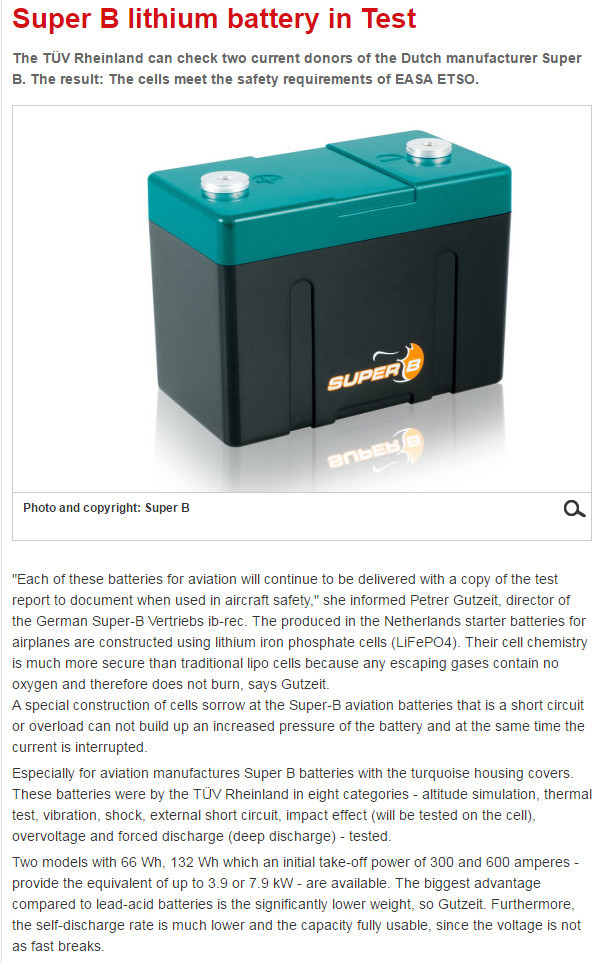Martin wrote:
And plenty of sailplanes have Lithium batteries to power equipment (they are lighter, smaller and don’t drop voltage as much as they discharge), but sailplanes are not as tightly regulated.
Sailplane batteries are charged in dedicated chargers outside the plane. It’s the chargers that are the problem (if any), not the batteries. I would never put one of those lithium batteries in my plane without a whole new digitally controlled alternator/generator technology.
@Peter, ok but you wouldn’t fit a Concorde battery like that in an experimental. The most common fit in a Vans would be an Odyssey PC680 (RV-7) or PC925 (RV-10), which retail at about $120 and $180 respectively. The (rough) equivalents would be the EarthX ETX680 and ETX900, which retail for about $380 and $450.
The smaller batteries are perfectly capable of starting the engine but (compared to your Concorde) they would lack capacity for sustained operation in the event of alternator failure. However, in a Vans, you typically meet that need by fitting a small second alternator on the vacuum pump pad. That weighs much less than the extra battery capacity and will produce amps for as long as the engine runs. It also gives you two electrical power sources, which is very sensible in an all electric aircraft, if it’s to be flown in IMC.
It’s the chargers that are the problem (if any), not the batteries
Not entirely. Overcharging is just one issue. Puncture, and various other mechanical damage, is another one. Probably the majority of fires are caused by mech damage. Loads of model plane batteries catch fire after a crash, for example.
I guess that with a fixed main battery, damage is unlikely, but you never know.
Peter wrote:
Puncture, and various other mechanical damage, is another one.
Mechanical damage is indeed a major problem. In our yearly dangerous goods courses they always show us a video (certainly available on YouTube somewhere) where a container containing LiPo batteries is being loaded into an aircraft and falls off the forklift from not more than one metre. It instantly starts smoking and blows up like a fireworks just a few seconds thereafter.
And recently, in the wake of the Paris terrorist attacks, a post office not far away from us was evacuated after an employee dropped a parcel from China on the floor that obviously contained some Lithium batteries. It too started smoking and exploded. Since there were more of these parcels in the shelf, they called for the bomb sqaud…
For aircraft usage, these batteries need to be enclosed very well, thereby reducing their low-weight advantage over other battery types.
LeSving wrote:
It’s the chargers that are the problem (if any), not the batteries.
There have been instances of fires in Li-batteries in cargo. They were clearly not being charged when they caught fire.
Airborne_Again wrote:
There have been instances of fires in Li-batteries in cargo. They were clearly not being charged when they caught fire.
There are different kinds of Li batteries. My eup is loaded with them, and they are the kind that do not catch fire or anything in a collision, as is all electric car batteries (Litium metal hydrid ?). Charging them correct is super critical however, and this requires high quality electrical supply as well as a charger (built into the car). There have been several problems with industrial quality fast chargers for cars. In an F-35, bizjets or airliners high quality chargers and supply shouldn’t be a problem.
There are lithium batteries and lithium batteries. LiFePO4 and Li(Y,Fe)PO4 are not only much less hazardous than ubiquitous LiPo and LiCoO2 or non-rechargeable Li/SOCl2 (of Tadiran fame), but even less hazardous than lead-acid: no corrosive electrolyte, no explosive gas released, very good behaviour on crush and puncture tests. They have also much less stringent charging requirements than LiPo and LiCoO2.
Super B Lithium battery (possibly certifiable?)
http://m.aerokurier.de/praxis/technik-zubehoer/super-b-getestet/704268
Interesting…
I recall speaking to the vendors of these at Aero Friedrichshafen over the years, asking them how does one charge these correctly from the standard 14V or 28V bus, and none of them wanted to talk about it.
I used to design battery charging circuits and one cannot simply charge these from a constant voltage bus and forget about them. Well, not if you want the full charge.
So how does this work?
I am sure it has been worked out because these have been around the homebuilt market for years, but it remains a mystery to me.
LIFE chemistry is the least likely to start a fire, but it is also the least performing by a big margin. I was going to use a small LIFE battery for the external camera project but in the end did not find one of a suitable form factor.
Google translated:

Peter wrote:
I used to design battery charging circuits and one cannot simply charge these from a constant voltage bus and forget about them. Well, not if you want the full charge.
Well, not if you want them to not burst into flames.
LiPoly/LiIon batteries need a charging circuit specific to them. I would suspect for a battery like this the charging circuit would be built into the battery itself so that you could connect it to a normal 14V/28V bus and the in-built charging circuit would take care of it. Laptop batteries, for instance, have an inbuilt charging circuit.